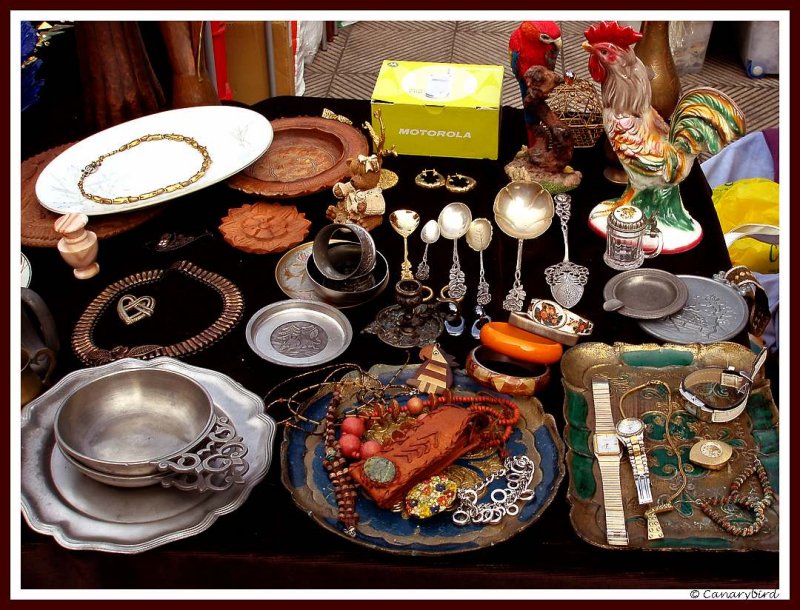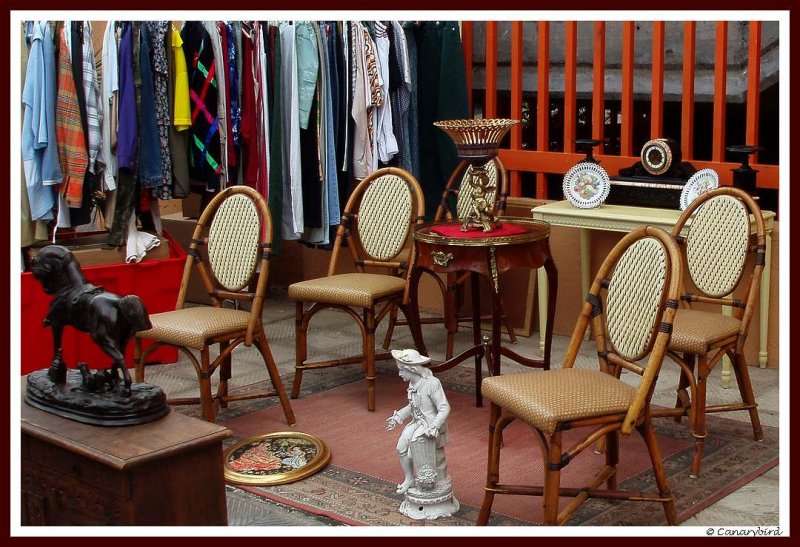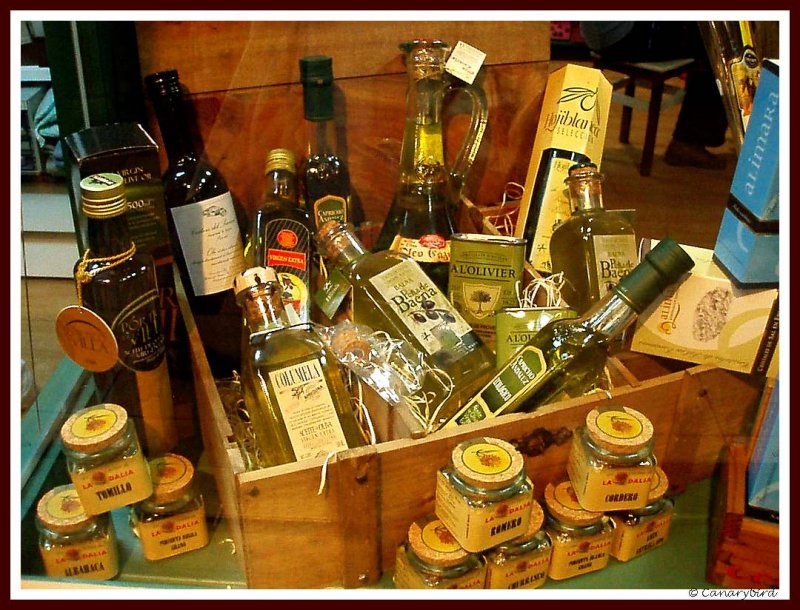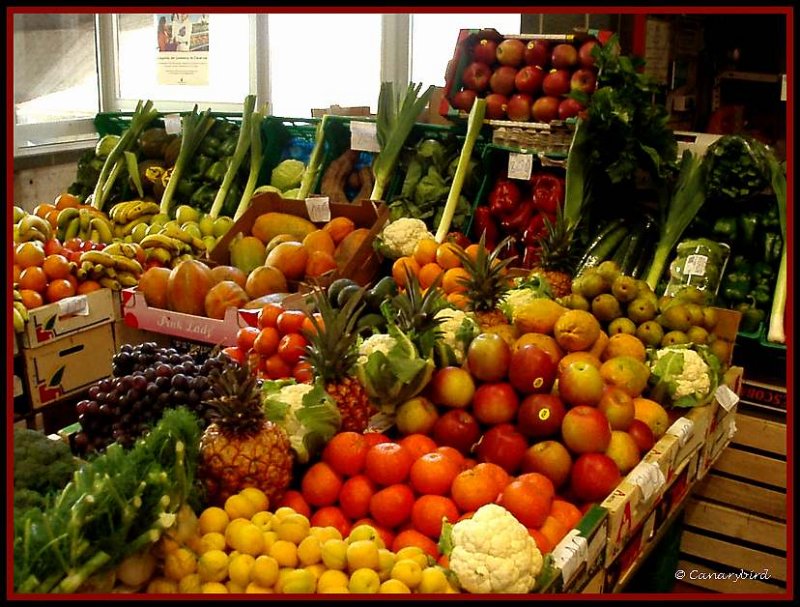
(click to enlarge photos)
Today I went down to the municipal market where the weekly Saturday flea market (
rastro in Spanish) is held outdoors on the forecourt and on the roof terrace. I was not one of the early birds because I like to sleep in Saturday mornings without having to set the alarm clock. So after a late breakfast I arrived just before noon when throngs of tourists and locals were perusing the goods offered on open tables. The day was overcast but warm and I was glad I hadn't worn a jacket or woolen sweater.
Note: The branch of pink blossoms in the foreground is from a little tree called
Bauhinia Variegata, originally from India and in English called 'pink camel's foot'.

I was surprised at the number of people though and believe that some of them must have come on tour buses from other parts of the island.

I was attracted to the silver spoons and indigo edged porcelain, but I know that I really don't need them any more than the person who gave them up for sale. More spoons and dishes require more cupboard space and I would rather eliminate some of my rarely used items than gather more. But they are lovely to look at and photograph.

I saw many people bending over tables carefully scrutinizing the smaller items but I saw only one person make a purchase while I was there.

I overheard one market seller comment to a friend that business was very slow, so it looked as though many people just came to browse. Here is a display of used furniture and other bric-a-brac. Obviously tourists would not be buying anything from there, since they come to the island by plane.

The stamp and coin collections are always popular, at least for those who like to look through them. I saw some old five peseta paper bills which I remember from my earliest years in Spain. They were later replaced with coins and still later eliminated all together when Spain joined the European community and adopted the new money. It was rather nostalgic to say goodbye to the old peseta currency. I even like the word
peseta better than
euro.
Peseta has such a Hispanic ring to it.

I approached the main market entrance, and went inside to look around. This area as well was thronged with people sitting at the small cafe, resting or milling around, glancing at expositions of tablecloths, clothing or handicraft items. Everyone welcome unless you were a dog!

I went to have a look at the stamp display of a man who said he was a collector and not a vendor. He seemed to be quite busy though with people who were interested in what he had on show. I'm sure he came to barter and trade with other like-minded people who shared his hobby. He said he was there every Saturday at the same place, and like me, he didn't like to get up early on a Saturday, so if anyone wanted to contact him, it had to be after 10 am.

Since I needed some vegetables for making our Sunday dinner I stepped on the escalator and went up to the second floor. It was also very busy there, but the displays of fruit and vegetables were a treat for the eyes. As is my custom, I walked first around the perimeter without buying to have a look at what was offered in each stall.

Here were lemons, chayotas and potatoes. Chayotas are a soft-skinned green vegetable with a mild, subtle flavour used often here in soups and stews. They grow quickly on sprawling vines which I once had in my garden and had to remove before they engulfed my other plants.

In the fish stall, a Moray eel lies between sardines, red mullet and other locally caught fish.

A gourmet shop exhibits a varied selection of olive oils and herbs.

Inside are imported European ecological products.

A line has formed outside a German deli offering wurst, sausages, pickles and potato salads as well as other typically German foods.

After I made my purchases of new potatoes, green spring onion, tomatoes, cucumber and sweet orange yams, I headed back downstairs to the outdoor forecourt. It was almost one pm and the flea market was quite deserted. The vendors were packing their goods into small vans and it was time for me to drive home.

I know that if I were to come here more often I would have to buy a second refrigerator! I cannot resist the bright colours and fresh scents of the fruits and vegetables on display and want to buy a little of each one. At least we are then obliged to have our five vegetables or salads every day, which can only be a good thing!
These photos were taken with the small point & shoot Olympus Stylus 800 camera.
 (click photos to enlarge)
(click photos to enlarge) I noticed the first nasturtium open in the garden this morning. It will be followed by many that will cover spare ground and tumble over low walls without need of encouraging fertilizer.
I noticed the first nasturtium open in the garden this morning. It will be followed by many that will cover spare ground and tumble over low walls without need of encouraging fertilizer. Italian parsley renews itself after seeds in pots have fallen and come to life.
Italian parsley renews itself after seeds in pots have fallen and come to life. The Agave Attenuata has finally bent over enough to touch the ground. Only a few flowers remain unopened at the tip.
The Agave Attenuata has finally bent over enough to touch the ground. Only a few flowers remain unopened at the tip.
 Our neighbour's cat basks in the morning sun, behind the Aloe Vera.
Our neighbour's cat basks in the morning sun, behind the Aloe Vera. Our grapefruit has confused its normal fruiting season due to an April heat wave last year which killed off the early buds. It's now trying to come back at a time when the grapefruits should be golden and ripe. One has an odd almost double shape.
Our grapefruit has confused its normal fruiting season due to an April heat wave last year which killed off the early buds. It's now trying to come back at a time when the grapefruits should be golden and ripe. One has an odd almost double shape. A blackbird...mirlo in Spanish...sits in our Jerusalem thorn tree. The garden is full of them at the moment flying to and fro with little beakfuls of straw and dead leaves as they build their nests.
A blackbird...mirlo in Spanish...sits in our Jerusalem thorn tree. The garden is full of them at the moment flying to and fro with little beakfuls of straw and dead leaves as they build their nests. The osteospermum are already blooming around the garden. They become so rampant that we have to cut them back continually.
The osteospermum are already blooming around the garden. They become so rampant that we have to cut them back continually.
 The first iris was out today.
The first iris was out today. Yesterday, our garden helper, Antonio, cut down the branches of green dates from our palm tree, Phoenix Canarensis, before the inedible little dates could ripen and fall to the ground, where they have an affinity for the bottoms of any shoes that may walk under the tree!
Yesterday, our garden helper, Antonio, cut down the branches of green dates from our palm tree, Phoenix Canarensis, before the inedible little dates could ripen and fall to the ground, where they have an affinity for the bottoms of any shoes that may walk under the tree!









































